The Friends of the Wildflower Garden, Inc.
Plants of the Eloise Butler Wildflower Garden
The oldest public wildflower garden in the United States

Common Name
Climbing Bittersweet (American Bittersweet)
Scientific Name
Celastrus scandens L.
Plant Family
Bittersweet (Celastraceae)
Garden Location
Upland
Prime Season
Late Spring to Early Summer flowering. Berries to late Autumn
Climbing Bittersweet is a native perennial woody climbing vine of sunny areas that flowers in late May and then produces a cluster of berries that gradually turn from green to yellow to orange over the season. Late in the fall the orange covering of the berry splits open along three division lines revealing a scarlet berry inside.
Stems: With support and left to grow over the years, the vine can become quite large and reach to 20 feet or more. Stems trail if there is no support. Young stems are green and hairless, turning brown and woody with age.
Leaves: The dark green leaves are stalked, oval, with sharp teeth, smooth on both sides, with a pointed tip, and borne alternately along the stem. They are about 2x as long as wide. There is a small stipule at the base of the leaf stalk.
The inflorescence is a panicle up to 6 inches long, of stalked flowers, terminal or rising from the upper leaf axils. Plants are usually dioecious (flower sexes on different plants), thus you must have both male and female plants for berries to form. Some plants however have perfect flowers.
The flowers are small, about 1/4 inch wide, 5-parted, yellowish-greenish, with a cup-shaped perianth with 5 triangular sepal tips, shorter than the petals which are a greenish-white and spread outward with the tips reflexing backward. Petal edges are wavy-ragged. Male flowers have 5 stamens with white filaments and yellow anthers. These rise from beneath a nectary at the base of the corolla. In female flowers, the style is yellowish-green and slender rising from an enlarged yellow-green 3-sectioned ovary. Female flowers also have 5 false stamens (staminodes). If there are bisexual (perfect) flowers they have all the parts combined except the staminodes are absent.
Fruit: Fertile flowers produce a round green seed capsule which, as it matures, changes color to end up a brownish-orange. The capsule then splits open into 3 sections and reveals a bright red three sectioned berry (technically called an 'aril') that contains the seeds, of which there are usually 2 per section of the aril. Seeds require at least 150 days of cold stratification for germination and must be kept in moist conditions.
Toxicity and Winter interest - see notes in bottom section of this page.
Habitat: Climbing Bittersweet grows best in full sun in rich soils. It will tolerate partial shade and moist to dry conditions. If it can attach to another sturdy plant or a structure it will climb upwards of 20 feet. In this case, as the plant ages, the lower stem sections will be bare.
Names: The genus Celastrus, is from the Greek word kelastros and refers to the evergreen holly Ilex aquifolium of Eurasia. The plant was not assigned this genus because it looks like holly, but because its flower and fruiting characteristics resemble it. The species, scandens, means 'climbing'. The author name for the plant classification - 'L.' is for Carl Linnaeus (1707-1778), Swedish botanist and the developer of the binomial nomenclature of modern taxonomy. The usage of the word 'bittersweet' comes from Colonial times when the red fruits were compared to the familiar nightshades whose fruit the colonists knew to taste 'bitter and then sweet'.
Comparison: American Bittersweet resembles the non-native Oriental Bittersweet (C. orbiculata) which is invasive and a pest in some states but not yet a pest in Minnesota. It has slightly different fruit clusters, being not just terminal, but along the stem from the leaf axils, and leaves that are rounded at the tip. Do not buy that plant. It can spread rapidly and exclude more desired vegetation. These are the only two species of Celastrus found in North America.

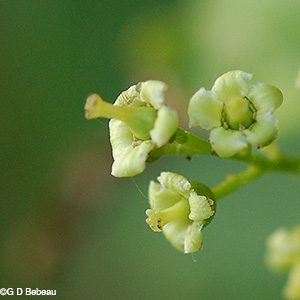
Above: 1st photo - The flower clusters of late spring. 2nd photo - Female Flowers. The staminodes are much smaller than the stamens of the male flowers.
Below: The five-parted small male flower with reflexed petals. Most plants have either male flowers or female flowers. Flowers shown below are male. Occasionally a plant may have perfect flowers.
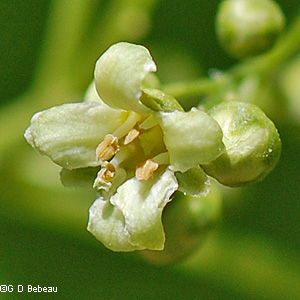
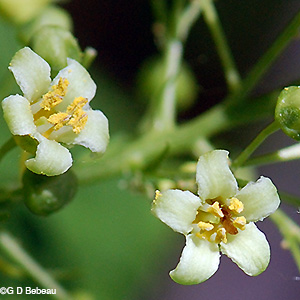
Below: 1st photo - The perianth is cup shaped with greenish-yellow triangular lobes to the sepals. 2nd photo - Leaves are oval with sharp marginal teeth and taper to a pointed tip.


Below: 1st photo - The trailing stems with alternate leaves with pointed tips. 2nd photo - The green fruit develops within a month of flowering.

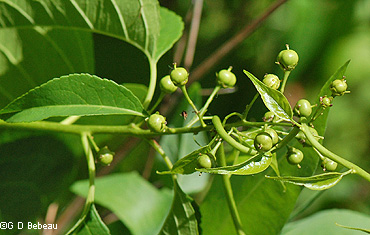
Fruit Development color changes.
Below: 1st photo - By early August the fruit is turning color. 2nd photo - Within three weeks the color has deepened as the fruit ripens.
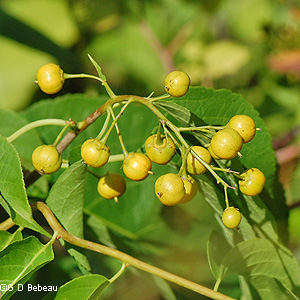

Below: In late October and early November the outer covering, now light brown in color, will split back revealing the scarlet 3-section berry (an aril) inside.
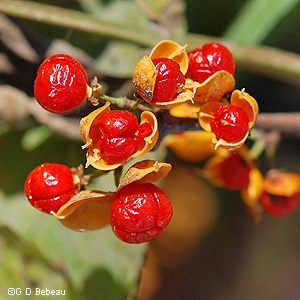

Below: The orange color of the capsules, prior to turning brownish, in early October before the leaves have turned color and dropped.
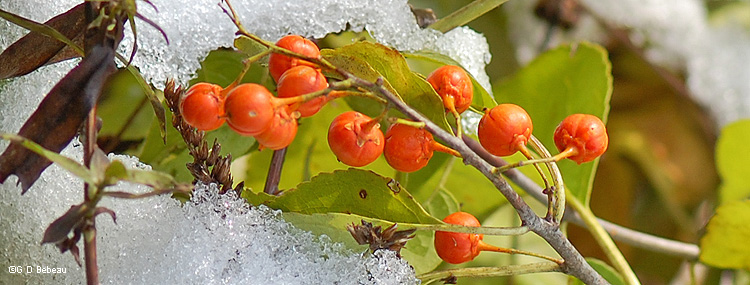
Below: The Invasive Oriental Bittersweet, C. orbiculata. Note that the fruit clusters appear not just at the terminal end of a stem but also along the stem where the leaf axils are. The leaves are also more rounded at the tip. Photo ©Jil M. Swearingen, USDI National Park Service.
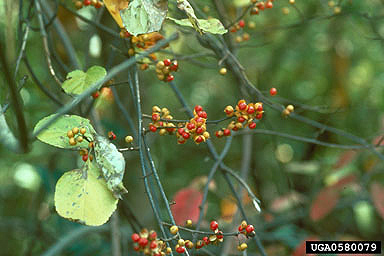
Notes: Climbing Bittersweet is indigenous to the Garden area. Eloise Butler catalogued it on April 29, 1907. On Oct. 16, 1913 she brought in 2 roots of female plants from what she called the "big bog" near Minnetonka and other plants in 1916. More were planted in 1922, '24, '25, and '28. Martha Crone planted it in 1947 and it was most recently planted by Curator Susan Wilkins in 2006. The plant is native to Minnesota in most counties. There are widely scattered exceptions with most exceptions located in the SW Quadrant of the State. In North America it is found in the eastern 2/3rds of the continent except for Florida and the Canadian maritime provinces. In our Upland Garden, the plants only grow as low vines. The photos above are all of vines in the Upland Garden.
Winter Interest: Once the leaves drop in the fall, the brilliant fruit clusters will remain through the winter if the birds don't frequent them. In the home garden setting it is frequently found growing on arbors and the sides of small buildings. The density of the branches on an older plant provides good cover for birds, both in winter and for summer nesting. Deer will browse young plants.
Toxicity: Fruits are poisonous to humans if eaten but don't seem to bother wildlife.
Return to -- Site Plan/Archive Index --or-- List of Common Plant Names -- or -- List of Scientific Names -- or --Home Page - - - Back to top.
References: Plant characteristics are generally from sources 1A, 32, W2, W3, W7 & W8 plus others as specifically applied. Distribution principally from W1, W2 and 28C. Planting history generally from 1, 4 & 4a. Other sources by specific reference. See Reference List for details.
 Identification booklet for most of the flowering forbs and small flowering shrubs of the Eloise Butler Wildflower Garden. Details Here.
Identification booklet for most of the flowering forbs and small flowering shrubs of the Eloise Butler Wildflower Garden. Details Here.
©2015
Friends of the Wildflower Garden, Inc. Text and photos are by G. D. Bebeau unless otherwise credited. "www.friendsofeloisebutler.org"
050320